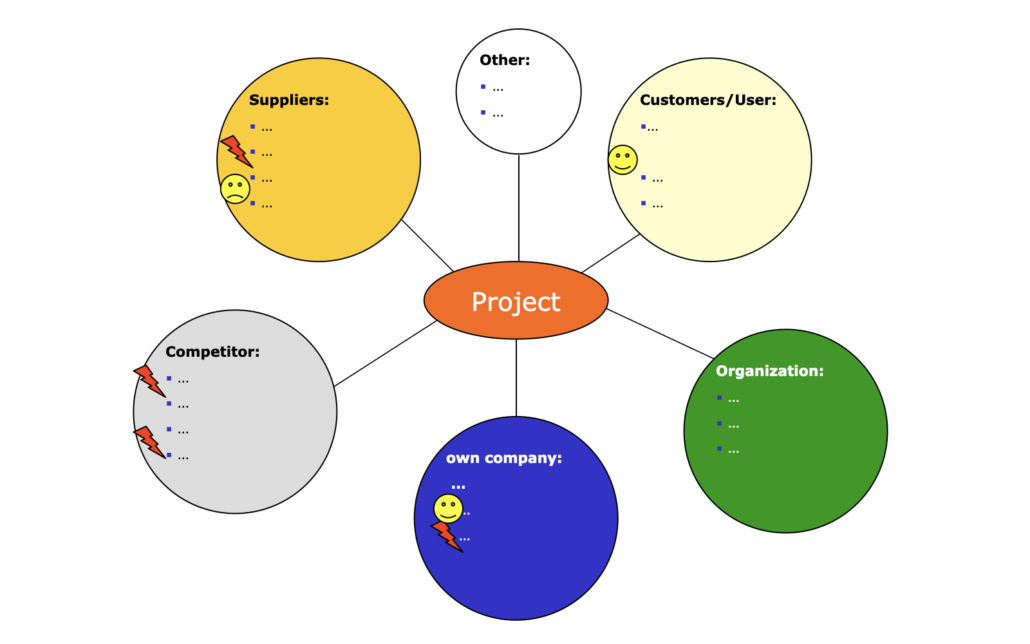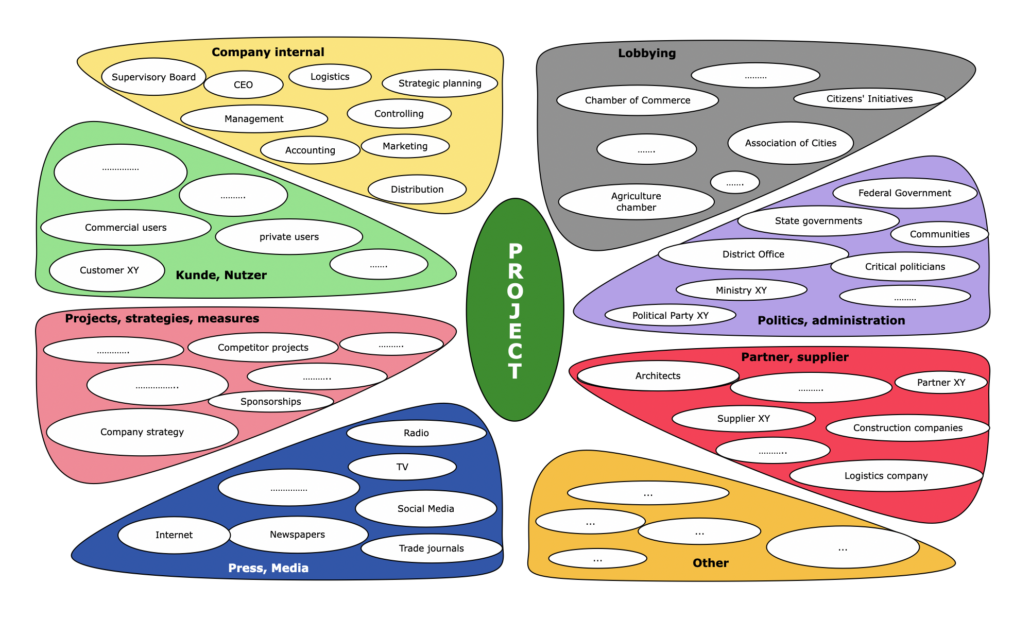The Stakeholder analysis is an important instrument for risk prevention in project management. It is developed in the start-up phase of a project and creates awareness of the factors influencing a project that can have a negative impact on the course of the project.
Projects are exposed to numerous influencing factors from inside and outside the company. There are dependencies to tasks and projects in the company. Economic and market influences cause changes in general conditions. Other disruptions of any kind, such as employee changes, also influence projects and can even throw them off track.
As in any company, the occasional look beyond the end of one’s nose is highly recommended in projects as well. In addition to project structuring by means of activity, time and communication plans, the influencing factors from inside and outside should not be disregarded.
Inhaltsverzeichnis
Definition Stakeholder analysis
The Stakeholder analysis is a project management method to determine framework conditions and factors influencing the project and to keep an eye on these factors and to take countermeasures in time if necessary.
The Stakeholder analysis enables an overview of the embedding of the project in its environment. Possible areas of tension and difficulties can thus be identified at an early stage and evaluated in terms of their influence on the project. This makes it possible for everyone involved to see where dependencies exist and where measures may need to be taken to avoid jeopardizing the success of the project.
Goals of the stakeholder analysis
- Early recognition of possible influences, disruptive factors and areas of tension in the project
- Representation of interfaces to other tasks and projects in the company
- Creation of awareness of project dependencies through graphical representation of the environments and the relationships between them
- Evaluation of possible effects on the project
- Definition of measures to bring the influencing factors on the project in line with the project interests
Stakeholder management means acting in advance instead of having to react to external constraints later!
Creating the stakeholder analysis
The stakeholder analysis is carried out as early as possible in the project, preferably during the start workshop, but in any case during the project planning phase.
In order to meet the requirement for completeness as far as possible, the environment analysis is carried out with the entire project team. It may also be possible to involve people from outside the project who have a good overview of the company or experience in similar projects and can thus contribute information on possible influencing factors.
However, not too many people should be involved; a number of 5-7 people has proven successful in practice. In any case, the project manager, the project client and a member of the steering committee or steering board (if available) should be involved.
Stakeholder identification
The first important task is to track down and identify all possible stakeholders and influencing factors. Depending on the project content and context, all factors that could influence the project or are affected by the project are listed. The brainstorming method is particularly suitable for this.
The designation of the environments is done in the first step on top level (production instead of Mr. Miller, print media instead of a certain newspaper, etc.).
In the second step, these groups are further detailed. Example: In the group Suppliers the companies are listed, which are classified from project view as particularly important for the project success. 08/15 suppliers, which can be exchanged easily, remain outside.
Summary in stakeholder groups/categories
In the publications, the clusters „organizational-social“ and „factual-substantial“ or internal and external environment groups are used to categorize the project influencing factors in the environment analysis. However, a more detailed categorization is recommended, especially in large projects.
Some stakeholder groups/categories may already be predefined by the project manager. Typical stakeholder groups/categories are:
- internal
- external
- customers / users
- suppliers / partners
- Competitors
- press / media
- other plans / projects / programs in the company
- corporate strategy, corporate measures
- Interest groups / associations
- politics / administration
- company management, opinion leaders, executives, employees, works council
Stakeholder Evaluation and Analysis
In the next step, the identified stakeholders are evaluated in terms of their influence on the project. Basically, a distinction is made between „positive“ and „negative“ influence. In addition, „power and influence on the project“ and „proximity“ to the project must also be taken into account.
Every project pursues a specific objective, which results in an influence on the project environment. The expectations of the stakeholders can be in conflict or in harmony with the project goals. Depending on this, conflicts or potentials are pre-programmed.
During the evaluation, one goes step-by-step through the identified influencing factors and interprets the possible influence on the project. Depending on the conclusion reached, the respective stakeholder groups are defined as „critical“ or „supportive“.
In this step, the inclusion of several opinions is enormously important, as otherwise a very subjective picture may emerge that is perhaps based on personal sensitivities towards certain environments.
Measures definition
The final step in preparing the stakeholder analysis is to define measures to support and manage particularly critical but also positive environments. Similar to the force field analysis, the goal here is also to „re-polarize“ negatively tuned environment groups and to strengthen the influence of the positively tuned ones as much as possible.
Depending on the urgency, immediate and precautionary measures can be taken. Contingency plans (Plan B) can also be found among the precautionary plans, which come into force when undesirable situations arise in order to enable a rapid response without loss of time.
Measures including deadlines and responsibilities are defined for each stakeholder group to be addressed. These can be recorded in a to-do list or included as separate work packages in the work breakdown structure (only recommended if the measures are correspondingly important and extensive). Regular controlling is important to ensure that these measures are actually implemented. This should be done as part of the periodic project controlling.
Stakeholder groups for which no measures are necessary – usually the majority – can be dealt with via general project communication and project marketing activities, if this makes sense.
The defined measures can be used to shape the relationship between project and stakeholder. The aim of the measures is to reduce the possible negative influence on the project in the case of critical influencing factors or to achieve a so-called „multiplier effect“ in the case of supporting influencing factors.

Documentation of the environment analysis
Visualization
The stakeholder analysis should be presented graphically in any case; this creates an overview. The presentation can be designed in such a way that as much information as possible is packed directly into the graphic. The use of symbols (lightning bolt, smiley, cloud, question mark, etc.) and/or color coding (e.g. traffic light system) offers many possibilities here.
Tabular representation
Detailed information should be presented in an additional table so that clarity is not lost. For example, expectations and fears from the project perspective, the importance of the stakeholders for the success of the project, and also the measures to be implemented with agreed responsibilities and deadlines can be documented here in detail.
Periodical review of the stakeholder analysis
Since the stakeholder analysis represents a snapshot, it must be checked for validity at regular intervals and adapted if necessary. Relevant persons, departments, suppliers, etc. as well as the potential influencing factors can change! For example, a supplier who was classified as absolutely uncritical and reliable 2 months ago may suddenly be in economic difficulties. Here, of course, new preventive measures have to be developed.
Agreed measures that may have seemed sensible months ago may also have to be revised or adapted.
Depending on the project size and duration, intervals of one to two months for a review of the stakeholder analysis are reasonable. Therefore, the stakeholder analysis should also be included in regular project controlling.
Stakeholder management is also an important part of risk management!
Examples of project stakeholder analysis
Stakeholder analysis for projects

Stakeholder analysis for major projects and programs

Tabular representation of the evaluation

Tips and tricks for practical use
- Only the development of the stakeholder analysis in a team enables a holistic and objective result
- Brainstorming has proven to be a good method for the creation of the first draft
- Clustering from the beginning quickly creates a clear structure
- Visualization creates transparency
- Define impacts and measures for critical and positive environments
- Define the catalog of measures for dealing with the environments as operationally as possible
- The stakeholder analysis and the defined measures must be regular agenda items in the controlling meetings
- The stakeholder analysis can be used as a starting point for the risk analysis.
